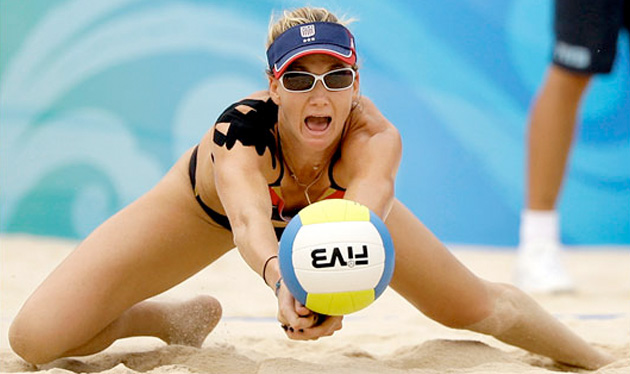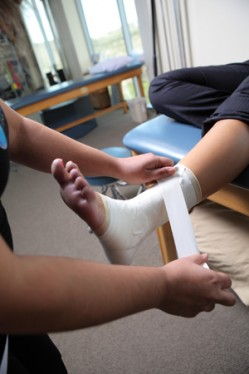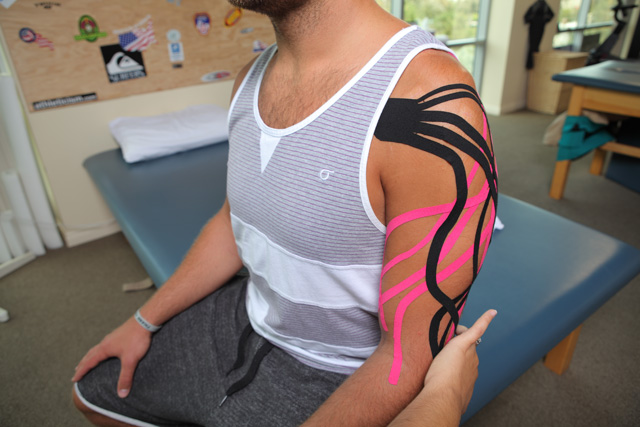Everyone saw two-time Olympic gold medalist, Keri Walsh, step foot on the beach volleyball court in Beijing in 2008 with black tape all over her shoulder. Since then, people have wanted to know what kind of tape she was wearing and can it help their various ailments. The popularity of “kinesiotape” has sky rocketed amongst sports medicine practitioners and their patients. And, the athlete herself now endorses a specific brand. But, the question remains, what are its true uses and how can it help people? And what about all the other tapes out there that various physical therapists, chiropractors, athletic trainers and other health care practitioners use? They fall loosely into three categories: corrective, supportive, and compressive.

Let’s begin with the “corrective” tapes such as kinesiotape. It is cloth based, with pressure grooves cut into the tape, and elastic properties that allow the applier to control the amount of stretch applied. It was originally developed in Japan in 1973 and officially introduced to the United States in 1995. Depending on its application, it can be used to support muscles, effect lymph function (through the pressure grooves), to correct joint problems and to decrease pain. When properly applied by a medical practitioner, the tape can help reeducate muscle function thereby reducing strain and pain. The correct application of the tape depends on the amount of tension applied, the start and end point of the tape, and whether or not it is applied as one strip or multiple “tails”. The benefits of the tape are quite broad and once a specific application is shown to be effective, the patient can be instructed to do it on their own. This tape may come in rolls or in pre-cut strips. Unlike most tapes, this tape can be worn for 3 to 4 days as long as there is no skin sensitivity or irritation.
Another set of commonly used “corrective” tapes include leukotape and coverall. They are latex free. These tapes are commonly used together by health care practitioners to correct joint positions such as the patellofemoral joint or the glenohumeral joint. These tapes are quite strong and have no elastic property to them. The tapes are applied to pull one bone back into alignment with the other. Because of the aggressive zinc oxide adhesive of the leukotape, the coverall is applied first when used on an area of the skin that might be sensitive to the adhesive. This tape should only be worn for 6-8 hours, initially, to assure there is no skin allergy or irritation to the adhesive. Additionally, care should be taken when removed from the skin, by pulling slowly, as this can also irritate the area.

The next category is the “supportive” tape such as athletic/sport tape (J&J tape). It is the most common tape found in athletic training rooms of various sports teams. This is a strong, white tape with minimal to no elastic properties. It comes in varying widths (1/2″” to 2″) and is used to support and limit movement around a specific joint. The tape has a zinc oxide ingredient and is porous so it breathes and tends to mold to the joint being taped. When body temperature rises, the tape can be become more cast like; therefore, more supportive. Athletic tape is commonly applied in a prophylactic manner using various circular patterns to create support in multiple directions. The ankle/foot, wrist, hand, and fingers are the most common areas to receive this type of taping. And, athletic trainers are the most common practitioners to apply it. These tapes are usually worn for a specific athletic activity and then removed, usually by a special blunt-edged scissors known as “shark scissors”.
A larger supportive tape would be Elastikon or Elastoplast. Elastikon elastic tape is made of a high twist, cotton elastic cloth tape with a rubber based adhesive, designed to help provide elasticity needed for dynamical pressure dressing. It is designed for maximum support to knees, elbow and shoulders. Elastoplast is a highly twisted crepe yarn with virgin cotton backing and a strong rubber based adhesive. Both these tapes are most commonly used in 2″ and 3″ sizes. These tapes, along with the athletic tape, would be considered the “strong tapes” Both tapes are commonly used for Achilles injuries or for extra support after an ankle sprain. This tape is typically removed the same day.
The final class of tape is used for compression, light support, or to cover other tapes. These include Coban and Lightplast. They are elastic cotton/spandex blends that offer elasticity with minimal support. Coban is self adhesive yet not sticky to the skin. It is often used over other tapes, particularly for athletes participating in sand sports. They are especially useful over the zinc oxide tapes, which tend to dry out and come off in the sand. The self-adhesive elastic tapes conform to the joint and add extra support which holds the under tape in place. This can be quite useful for ankle tapings. Lightplast is adhesive to the skin and offers a lighter elastic support. Both tapes are great for elbows, wrists, and hands when a light compression is needed that only minimally restricts joint mobility. These tapes are typically removed the same day.
One final tape worth mentioning is water-proof tape or wet-proof tape. This type of tape is flexible, water proof and washable. It has the unique ability to adhere even when the body area is wet. This is especially useful if the person is in the water or there is perfuse sweating. The tape is usually “skin friendly” and ideal for people with skin hypersensitivity or a tendency towards skin allergies.
With all these categories of tape, the effectiveness and success of the tape is dependent on its application. None of the tapes are “magic” yet each have the potential to help a person enormously IF applied correctly by an experienced clinician. A person entering a pharmacy looking for tape should always be directed to a local clinician (physical therapist, athletic trainer, chiropractor, etc.) who has experience with the tape and can teach them to apply it correctly. Additionally, all patients should be made aware of possible skin irritation to the adhesives. Products such as “tough skin” can be sprayed on the area beforehand, and various adhesive removers can be used afterwards to remove the rest of the adhesive.
TYPES OF TAPE
| Name | Category | Body Part | Injury | Comments |
| Kinesiotape | Corrective | Any | Muscle, Joints, Edema | Many uses depending on application |
| Leukotape | Corrective | Knee, Shoulder, Foot | Joints | Use Coverall under to protect skin |
| Coverall | Corrective | Knee Shoulder, Foot | Joints | Use under Leukotape |
| Athletic Tape | Support | Ankle, Foot, Wrist, Hand | Joints | Varies in size: 1/2″ to 2″ |
| Elastikon | Support | Knee, Shoulder, Ankle, Foot | Sprains, Strains | 2″ and 3″ sizes |
| Elastoplast | Support | Knee, Shoulder, Ankle, Foot | Sprains, Strains | 2″ and 3″ sizes |
| Coban | Compression | Ankle, Wrist, Hand | Sprains, Strains | Self-adhesive, used over other tapes |
| Lightplast | Compression | Ankle, Wrist, Hand | Sprains, Strains | Sticks to skin |
| Wet Proof | Support | Knee, Shoulder | Sprains, Strains | Good for water sports or excessive sweating |



